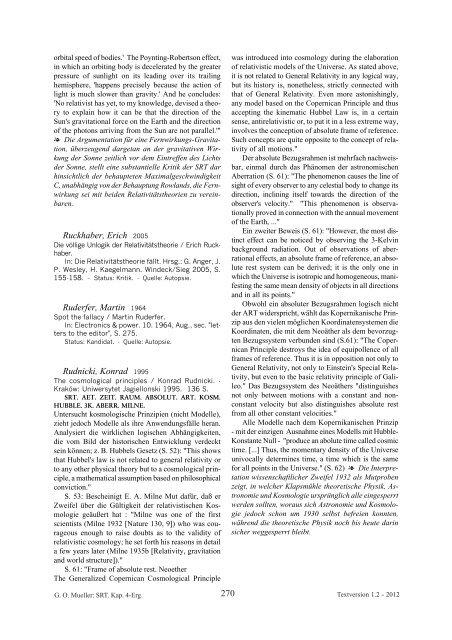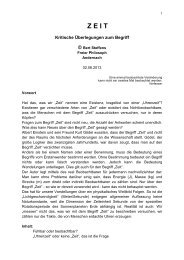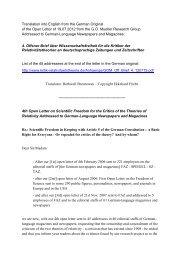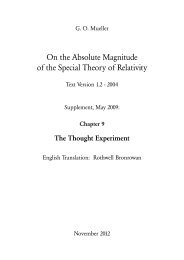2394 weitere kritische Veröffentlichungen - Kritische Stimmen zur ...
2394 weitere kritische Veröffentlichungen - Kritische Stimmen zur ...
2394 weitere kritische Veröffentlichungen - Kritische Stimmen zur ...
Sie wollen auch ein ePaper? Erhöhen Sie die Reichweite Ihrer Titel.
YUMPU macht aus Druck-PDFs automatisch weboptimierte ePaper, die Google liebt.
orbital speed of bodies.' The Poynting-Robertson effect,<br />
in which an orbiting body is decelerated by the greater<br />
pressure of sunlight on its leading over its trailing<br />
hemisphere, 'happens precisely because the action of<br />
light is much slower than gravity.' And he concludes:<br />
'No relativist has yet, to my knowledge, devised a theory<br />
to explain how it can be that the direction of the<br />
Sun's gravitational force on the Earth and the direction<br />
of the photons arriving from the Sun are not parallel.'"<br />
� Die Argumentation für eine Fernwirkungs-Gravitation,<br />
überzeugend dargetan an der gravitativen Wirkung<br />
der Sonne zeitlich vor dem Eintreffen des Lichts<br />
der Sonne, stellt eine substantielle Kritik der SRT dar<br />
hinsichtlich der behaupteten Maximalgeschwindigkeit<br />
C, unabhängig von der Behauptung Rowlands, die Fernwirkung<br />
sei mit beiden Relativitätstheorien zu vereinbaren.<br />
Ruckhaber, Erich 2005<br />
Die völlige Unlogik der Relativitätstheorie / Erich Ruckhaber.<br />
In: Die Relativitätstheorie fällt. Hrsg.: G. Anger, J.<br />
P. Wesley, H. Kaegelmann. Windeck/Sieg 2005, S.<br />
155-158. - Status: Kritik. - Quelle: Autopsie.<br />
Ruderfer, Martin 1964<br />
Spot the fallacy / Martin Ruderfer.<br />
In: Electronics & power. 10. 1964, Aug., sec. "letters<br />
to the editor", S. 275.<br />
Status: Kandidat. - Quelle: Autopsie.<br />
Rudnicki, Konrad 1995<br />
The cosmological principles / Konrad Rudnicki. -<br />
Kraków: Uniwersytet Jagiellonski 1995. 136 S.<br />
SRT. AET. ZEIT. RAUM. ABSOLUT. ART. KOSM.<br />
HUBBLE. 3K. ABERR. MILNE.<br />
Untersucht kosmologische Prinzipien (nicht Modelle),<br />
zieht jedoch Modelle als ihre Anwendungsfälle heran.<br />
Analysiert die wirklichen logischen Abhängigkeiten,<br />
die vom Bild der historischen Entwicklung verdeckt<br />
sein können; z. B. Hubbels Gesetz (S. 52): "This shows<br />
that Hubbel's law is not related to general relativity or<br />
to any other physical theory but to a cosmological principle,<br />
a mathematical assumption based on philosophical<br />
conviction."<br />
S. 53: Bescheinigt E. A. Milne Mut dafür, daß er<br />
Zweifel über die Gültigkeit der relativistischen Kosmologie<br />
geäußert hat : "Milne was one of the first<br />
scientists (Milne 1932 [Nature 130, 9]) who was courageous<br />
enough to raise doubts as to the validity of<br />
relativistic cosmology; he set forth his reasons in detail<br />
a few years later (Milne 1935b [Relativity, gravitation<br />
and world structure])."<br />
S. 61: "Frame of absolute rest. Neoether<br />
The Generalized Copernican Cosmological Principle<br />
G. O. Mueller: SRT. Kap. 4-Erg.<br />
270<br />
was introduced into cosmology during the elaboration<br />
of relativistic models of the Universe. As stated above,<br />
it is not related to General Relativity in any logical way,<br />
but its history is, nonetheless, strictly connected with<br />
that of General Relativity. Even more astonishingly,<br />
any model based on the Copernican Principle and thus<br />
accepting the kinematic Hubbel Law is, in a certain<br />
sense, antirelativistic or, to put it in a less extreme way,<br />
involves the conception of absolute frame of reference.<br />
Such concepts are quite opposite to the concept of relativity<br />
of all motions."<br />
Der absolute Bezugsrahmen ist mehrfach nachweisbar,<br />
einmal durch das Phänomen der astronomischen<br />
Aberration (S. 61): "The phenomenon causes the line of<br />
sight of every observer to any celestial body to change its<br />
direction, inclining itself towards the direction of the<br />
observer's velocity." "This phenomenon is observationally<br />
proved in connection with the annual movement<br />
of the Earth, ..."<br />
Ein zweiter Beweis (S. 61): "However, the most distinct<br />
effect can be noticed by observing the 3-Kelvin<br />
background radiation. Out of observations of aberrational<br />
effects, an absolute frame of reference, an absolute<br />
rest system can be derived; it is the only one in<br />
which the Universe is isotropic and homogeneous, manifesting<br />
the same mean density of objects in all directions<br />
and in all its points."<br />
Obwohl ein absoluter Bezugsrahmen logisch nicht<br />
der ART widerspricht, wählt das Kopernikanische Prinzip<br />
aus den vielen möglichen Koordinatensystemen die<br />
Koordinaten, die mit dem Neoäther als dem bevorzugten<br />
Bezugssystem verbunden sind (S.61): "The Copernican<br />
Principle destroys the idea of equipollence of all<br />
frames of reference. Thus it is in opposition not only to<br />
General Relativity, not only to Einstein's Special Relativity,<br />
but even to the basic relativity principle of Galileo."<br />
Das Bezugssystem des Neoäthers "distinguishes<br />
not only between motions with a constant and nonconstant<br />
velocity but also distinguishes absolute rest<br />
from all other constant velocities."<br />
Alle Modelle nach dem Kopernikanischen Prinzip<br />
- mit der einzigen Ausnahme eines Modells mit Hubble-<br />
Konstante Null - "produce an abolute time called cosmic<br />
time. [...] Thus, the momentary density of the Universe<br />
univocally determines time, a time which is the same<br />
for all points in the Universe." (S. 62) � Die Interpretation<br />
wissenschaftlicher Zweifel 1932 als Mutproben<br />
zeigt, in welcher Klapsmühle theoretische Physik, Astronomie<br />
und Kosmologie ursprünglich alle eingesperrt<br />
werden sollten, woraus sich Astronomie und Kosmologie<br />
jedoch schon um 1930 selbst befreien konnten,<br />
während die theoretische Physik noch bis heute darin<br />
sicher weggesperrt bleibt.<br />
Textversion 1.2 - 2012





